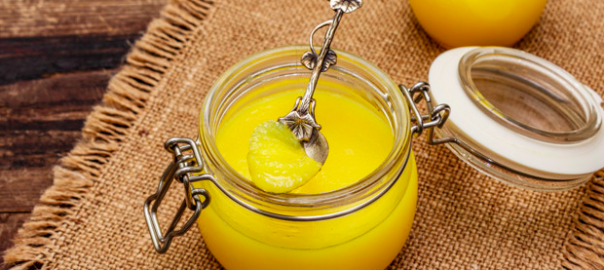Cooking with ghee
When looking for healthy fats to cook with my favorite choices are olive oil, coconut oil, avocado oil, butter, and ghee. I really like using ghee because it has a wonderful sweet flavor and it's easy to use.
Originating in India, ghee is simply clarified butter. In other words, butter that has been gently cooked to a point where the moisture evaporates and you can separate out the milk solids. Because it doesn't have the milk solids to go rancid, ghee can last for a very long time at room temperature (a good thing here in Texas where butter left on the counter would turn liquid and then go bad in very short order). Ghee also has a higher smoke point than butter (485 F for ghee vs. 350 F for butter) making it a really good all-around fat for sauteeing, baking, and roasting.
Nutrition facts
- Ghee can be a healthy choice for many people lactose intolerance. This is because all of the milk-fat solids have been separated out.
- Grass-fed dairy has higher levels of Conjugated Linoleic Acid (CLA). This means when using grass-fed butter to make ghee, it also has higher levels of CLA. Studies have shown that CLA
- Ghee, especially when made from grass-fed butter, is very high in the fat-soluble vitamins A, E, and K. These vitamins are important for the immune system, supportive for your metabolism, and beneficial for teeth and bones.
- CLA is very helpful for reducing inflammation, making it a good choice to add it to your diet.
- CLA appears to be cardioprotective with results showing “improved aortic sinus atherosclerosis“
- Studies have shown CLA to be helpful for weight loss
- Studies have also indicated that it can be anticarcinogenic
How to make ghee
The better the quality of your butter the better flavor your ghee will have. My recommendation is to use unsalted butter from pastured or free-range cows that have been grass-fed (in other words, no grains in their diet). 16 ounces of butter will yield approximately 12 ounces of ghee. The most important thing to remember is that you need to watch it the entire time because it goes from being done to burnt in a snap.
- Put your unsalted butter into a thick bottom pan and cook on medium heat until it starts to boil
- It will start to foam and crackle as the milk solids condense and the water boils off. If you want you can turn it down just a smidge at this point
- I scrape off the milk solids foam because I save it as a treat for my dogs but most folks just leave them because they will eventually settle to the bottom of the pot
- After approximately 15-20 minutes you will see that the ghee is a clear golden color and the dark brown milk solids are on the bottom of the pot. This is where you need to be careful. You want to make sure all the ghee is clarified and you can see all the way to the bottom of the pot
- Remove the ghee from the heat and strain. I use a fine-mesh strainer lined with two paper coffee filters into a measuring cup
- Let the ghee sit for about 10 minutes and then pour it into a clean glass jar to finish cooling
- It can be stored at room temperature for the softest, best use consistency
While it is possible to make ghee using your oven or your slow cooker, those both take significantly more time. This is such a simple process and doesn't take very long. In my opinion, it's worth it to simply do the traditional stovetop method
How to use ghee
There are any number of delicious ways to add ghee to your diet. Here are a few of my favorites. If you want to temper the flavor of the ghee a little you can mix it half and half with coconut oil. Once you start using ghee you'll discover how much you enjoy it. You may even find yourself adding it to almost everything.
- A teaspoon in a cup of tea or coffee for a wonderful flavor and energy boost. Ghee is also a-maz-ing when you put a dollop into a cup of hot chocolate.
- If you love a hearty breakfast with overnight oats or some other grain, ghee can be a wonderful topping with a little cinnamon and some chopped nuts
- Add just a little to cooked vegetables to give them a delicious finish. I find it's best to add the ghee before any last seasonings or herbs
- It's also great for mashed vegetables like sweet potatoes, turnips, or other root vegetables
- Amazing on a muffin or a slice of zucchini bread, I find the caramel-y flavor of ghee better than butter for these snacks
- Speaking of snacks, ghee is amazing on popcorn
- When baking you can substitute equal parts ghee for any recipe calling for butter
Given the health benefits, and the delicious nutty flavor, it makes sense to add ghee to your real food diet as an option for a nourishing fat.
[expand title=”Sources”]
Ha, YL, et al.Anticarcinogens from fried ground beef: heat-altered derivatives of linoleic acid. Carcinogenesis. 1987 Dec;8(12):1881-7
Kanter, JE, et al. 10,12 Conjugated Linoleic Acid-Driven Weight Loss Is Protective against Atherosclerosis in Mice and Is Associated with Alternative Macrophage Enrichment in Perivascular Adipose Tissue. Nutrients. 2018 Oct 3;10(10).
Zulet, MA, et al. Inflammation and conjugated linoleic acid: mechanisms of action and implications for human health. J Physiol Biochem. 2005 Sep;61(3):483-94
[/expand]
.


